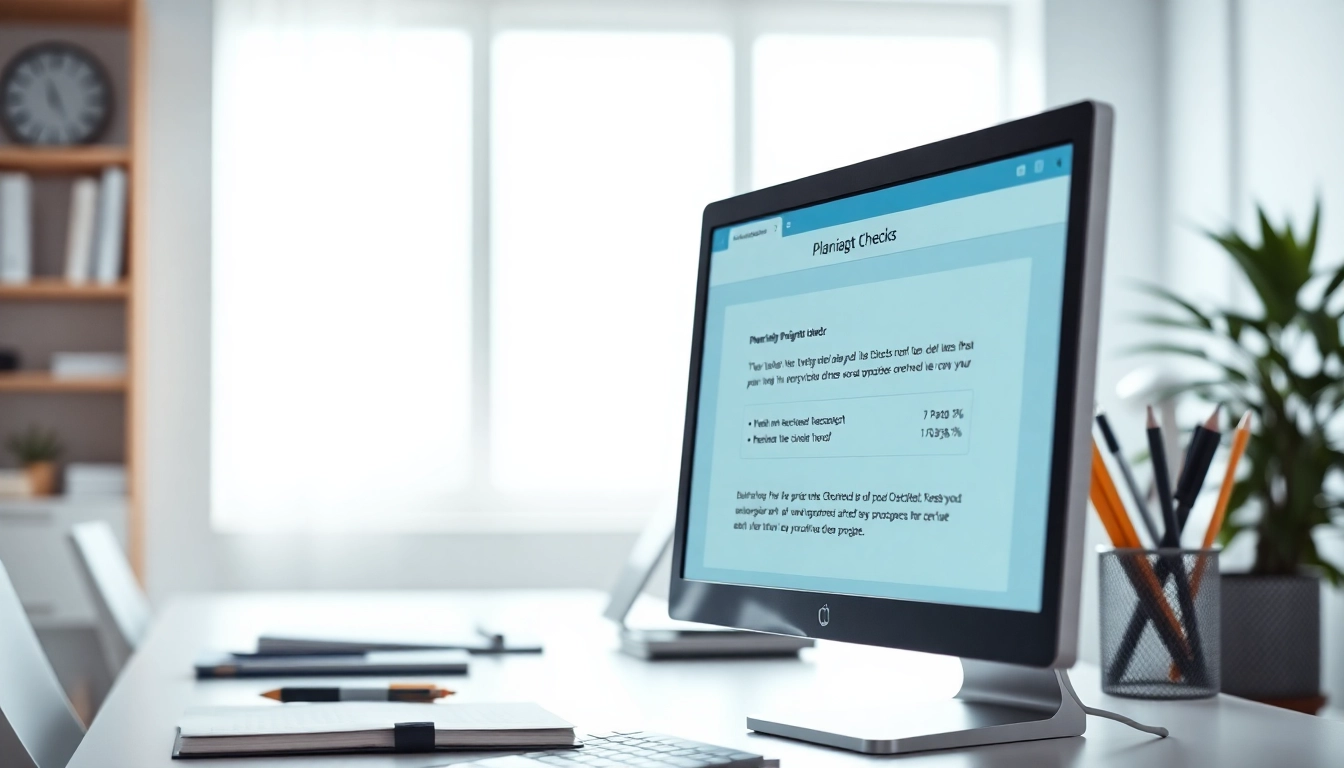Understanding the Need for a Plagiarism Checker
In an age where information is readily accessible, ensuring the authenticity and originality of written content is paramount. The rise of the internet has made it easier to share knowledge, but it has also made it easier to unintentionally or intentionally copy someone else’s work. This is where a plagiarism checker becomes an invaluable tool for students, educators, and content creators alike. Plagiarism checkers not only help in identifying copied material but also contribute significantly to maintaining academic integrity and originality in published work.
What is a plagiarism checker?
A plagiarism checker is a tool designed to detect instances of plagiarism in a given text. By comparing the submitted content against an extensive database of online sources, academic papers, and publications, these tools are capable of identifying similarities and potential overlaps. This process involves analyzing text for phrases, sentences, and sections that may not be original and may require citation or revision to ensure compliance with intellectual property rights.
Common uses for plagiarism checkers
Plagiarism checkers serve a variety of purposes across different sectors:
- Academic Institutions: Schools and universities often use these tools as part of their academic integrity policies to ensure students submit original work.
- Authors and Writers: Professionals in writing-intensive fields use plagiarism checkers to guarantee that their content is unique and avoid potential legal issues associated with copyright infringement.
- Businesses: Companies utilize these tools to verify the originality of marketing content, reports, and other written materials to maintain brand authenticity.
- Publishers: Publications ensure that articles and research papers submitted for publication are free of plagiarism, sustaining their reputation and avoiding ethical dilemmas.
Challenges in academic integrity
While most institutions promote originality, challenges abound in maintaining academic integrity. Factors such as easy access to information, misunderstandings about proper citation practices, and the pressure to produce high-quality work can lead to unintentional plagiarism. By utilizing a plagiarism checker, individuals can navigate these challenges more effectively, ensuring their work adheres to integrity norms and avoids the pitfalls of misconduct.
How a Plagiarism Checker Works
Understanding the functionality of a plagiarism checker is crucial for users to maximize its effectiveness. The mechanisms behind these tools involve complex algorithms designed to perform thorough content analysis.
Overview of algorithms used
Plagiarism checkers generally employ a range of algorithms to compare submitted text against vast databases of source materials. These algorithms can use:
- String Matching: This method identifies exact matches of phrases and sentences within the text.
- Fingerprinting: This technique involves creating unique fingerprints for documents to identify similarities without comparing the entire content directly.
- Semantic Analysis: Advanced tools can even analyze the meaning and context of sentences, identifying content that, while phrased differently, conveys the same idea.
Types of content analyzed
Most plagiarism checkers analyze various types of content, including:
- Text Document Formats: Common file types such as .doc, .pdf, and .txt are supported for upload and analysis.
- Web Content: Online articles, blogs, and posts are often included in database comparisons to identify matches.
- Academic Publications: Research papers and articles available in journals are analyzed to check for originality against scholarly work.
Understanding similarity reports
Once the analysis is complete, most plagiarism checkers generate a similarity report outlining the degree of overlap between the submitted content and the source materials. This report typically includes:
- Percentage of Similarity: A metric representing the proportion of the document that matches other sources.
- Source Listings: References to the original content identified in the comparison.
- Highlighted Text: Segments of the submitted text that are flagged as potentially plagiarized.
Choosing the Right Plagiarism Checker
Selecting an appropriate plagiarism checker requires careful consideration of various factors to ensure it meets the user’s specific needs.
Key features to consider
When evaluating different plagiarism checkers, look for key features such as:
- Database Size: A larger database increases the likelihood of detecting plagiarized content.
- Real-time Checking: Some tools offer instant analysis, saving time during the writing process.
- Multiple File Formats: Ensure the checker can handle various file types so that it fits seamlessly into your workflow.
- Detailed Reporting: Comprehensive reports enhance understanding and allow for effective revisions.
Free versus paid options
While numerous free plagiarism checkers are available, they may come with limitations, such as restricted database access or report detail. Paid options typically provide:
- In-depth Analysis: Subscribers gain access to more extensive databases that include academic publications and other proprietary sources.
- Advanced Features: Paid services often include additional functionalities such as grammar checking or citation generation.
User experience and interface design
A user-friendly interface enhances the usability of a plagiarism checker. Key usability aspects include:
- Intuitive Navigation: Simple menus and instructions significantly improve the user experience.
- Visual Feedback: Clear visual indicators and reports make it easier to interpret findings.
Best Practices for Using a Plagiarism Checker
To use a plagiarism checker effectively, implement best practices that encourage originality while maintaining quality in writing.
Combining manual and automated checks
Automated plagiarism detection tools are invaluable, but combining their use with manual checks can enhance results. Here’s how:
- Initial Automated Check: Utilize the plagiarism checker to identify any obvious overlaps or citations that may be necessary.
- Manual Review: Read through the flagged sections to ensure that the context is accurate and that your original ideas are well articulated.
Interpreting results effectively
Results from a plagiarism checker can feel overwhelming. Learning to interpret these results is essential:
- Focus on Context: Not all similarities indicate plagiarism; consider the context of the flagged text.
- Citation Needs: Identify if certain phrases require citations and ensure they are properly formatted.
Ensuring proper citations
Regardless of whether a plagiarism checker flags text or not, maintaining a strong understanding of citation methodologies is crucial. Different formats (APA, MLA, Chicago, etc.) have unique citation rules for various sources. Familiarizing yourself with proper citation practices will mitigate risks and enhance the credibility of your work.
The Future of Plagiarism Checkers
As technology continues to advance, the future of plagiarism checkers looks promising. Emerging trends and innovations will likely reshape how plagiarism is detected and addressed in written work.
Technological advancements in detection
Future plagiarism checkers may leverage:
- Artificial Intelligence: AI could improve detection algorithms, allowing tools to understand content on a deeper level, such as contextual meaning and intent.
- Machine Learning: With continued learning from user data, these tools can refine their accuracy and adapt to new trends in writing styles.
Integration with writing tools
Incorporating plagiarism checkers directly within word processing or writing software could streamline the process for users, making it easier to check content for originality as it is being created, thereby fostering a more conscientious writing practice.
Setting standards in originality
The ongoing development and refinement of plagiarism detection tools can lead to higher standards of originality in all forms of written content. This will likely foster a culture that prioritizes content ownership, authenticity, and ethical writing practices.















Leave a Reply